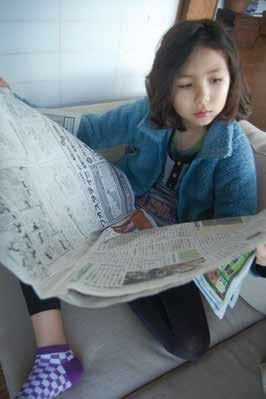Issue:
If the newspaper business has any future, it may lie in the loyalty of today’s young readers of newsprint

In these dark days for the newspaper business, only a few dailies can boast sales of 100,000, and the number is shrinking. Remarkably, the Asahi Shogakusei Shimbun achieves that figure by targeting what we might call a niche readership six to twelve-year-old Japanese kids. And while that might be a niche market, if we put it those figures in perspective, that’s roughly twice the circulation of the London Independent and quadruple the daily sales of The Japan Times.
The Asahi works hard not to patronize its pint-sized customers. Political stories regularly run on the front page. January splashes include Prime Minister Shinzo Abe’s controversial visit to Yasukuni and the reelection of a local mayor who opposes U.S. military bases on Okinawa. The paper even comes in an old-fashioned broadsheet format because, well, that’s what adults read, says chief editor Yasushi Matsumura.
“We want the children to feel like mom and dad when they pick up our paper,” he explains. “The idea is to get them reading and interested in news early.”
Japan, it turns out, has a vibrant market for newspapers targeting young readers. The Yomiuri Kodomo Shimbun claims a daily circulation of 200,000, though its rivals say those are not standalone sales but include those bundled with the parent paper. The Mainichi, Chunichi and about 30 other national and regional newspaper companies also publish dedicated titles for kids.
The practice makes sound commercial sense. Getting children into the newspaper-reading habit early helps build customers for life and encourages brand loyalty, points out Matsumura. And Japan can teach the world a thing or two about holding onto customers. While sales have gone into free fall throughout the developed world, around 90 percent of Japanese parents still subscribe to a hardcopy newspaper, delivered at the crack of dawn to their doors.
Some publications have taken the search for the next reading generation a step further. Tokyo Shimbun has developed a smartphone application that changes the contents of its newspaper into a more child-friendly version: hiragana reading aids and explanatory notes pop up in stories about politics and economics; cartoon characters appear on screen to help jog the reader along. (Search YouTube with “Tokyo Shimbun Children”)
One reason why there are so many newspapers for kids, clearly, is Japan’s declining population, which is forcing proprietors to think much harder about where the next reader is going to come from. Matsumura also credits the education ministry, which three years ago revised its guidelines for school teaching materials to include newspapers. Like many educators, the ministry’s bureaucrats blame the internet and video games for a national decline in reading ability.
One of the industry’s unspoken secrets, however, is that old folk are also reading kids’ publications. Many pensioners struggle with the kanji characters and stiff presentational style of adult newspapers and TV news programs. One telling sign that children’s product sometimes misses its target demographic was the cancellation three years ago of NHK show Shukan Kodomo no News (“Weekly News for Children”) after the producers found that most viewers were in fact elderly adults.
The original presenter of that program, Akira Ikegami, is also a famous proselytizer for early newspaper reading. His interventions, along with the education ministry’s push, helped trigger a rush of new titles in 2011. After over 40 years leading the pack, Asahi Shogakusei now finds itself in a crowded, hyper-competitive market. Circulation has fallen from 150,000 three years ago.
Still, the title is doing well, insists Matsumura, pulling in ¥500 million in profit a year. Unlike some of its competitors, his company is financially independent, though many of its writers and editors are loaned from the Asahi parent and it shares offices with the Asahi’s headquarters in downtown Tokyo. The company also publishes other titles, including a twice-weekly newspaper for junior high school students.
The Shogakusei formula is simple. Content is divided into news mostly sourced from the parent paper study and entertainment. Editors make the text simpler to understand, adding hiragana, illustrations and diagrams, but trying not to let images overwhelm the all-important words. A small team of writers produces features that might appeal to the under-12s: Recent examples include a story about hot carbonated drinks and another about Japan’s top dodge-ball team. Professors and educators are drafted in to explain complex issues in simple, direct language.
As for politics, Matsumura says the editor’s strive for a studiously neutral, descriptive tone. The January Yasukuni story simply reports that Abe went, that China and South Korea were upset and that Washington, unusually, was “disappointed.” A larger front-page story last August used a Q&A format to explain in some detail the background to the controversy, including the 1978 decision to enshrine Japan’s World War II military and political leaders. But it ended with a shrug of the shoulders, concluding that the issue is “difficult” and won’t be resolved soon. “We try not to impose views on young people who haven’t formed their own yet,” says Matsuyama.
Electronic delivery systems of course could all make this obsolete. Better-off kids are increasingly using e-tablets, shunning paper formats. But the Asahi is keeping its online plans close to its chest. “We are preparing for something but I shouldn’t discuss it,” says Matsumura. He says competition and the falling school-age population make optimism ‘difficult.’ Still, the newspaper business has survived radio, television, the Sony PlayStation and the smartphone and always manages to adapt. Even AKB48 has its own newspaper, though in that case pictures probably trump words.
David McNeill writes for The Independent, The Economist, The Chronicle of Higher Education and other publications.

